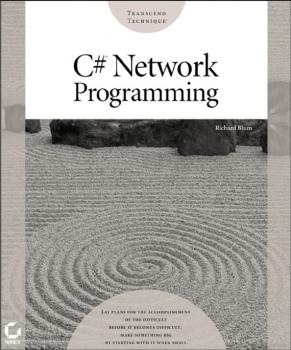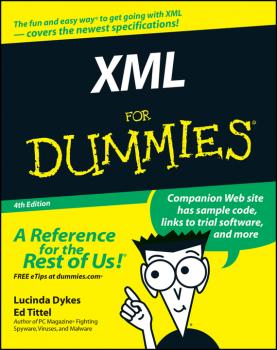Программирование
Различные книги в жанре ПрограммированиеJava Foundations
The world of IT is always evolving, but in every area there are stable, core concepts that anyone just setting out needed to know last year, needs to know this year, and will still need to know next year. The purpose of the Foundations series is to identify these concepts and present them in a way that gives you the strongest possible starting point, no matter what your endeavor. Java Foundations provides essential knowledge about what has arguably become the world's most important programming language. What you learn here will benefit you in the short term, as you acquire and practice your skills, and in the long term, as you use them. Topics covered include: The history of Java Java fundamentals Keywords and operators Flow control Arrays Basic and advanced concepts in object-oriented programming Exception handling Standard Java API classes The collections framework
Beginning SQL
Taking readers through the basics of the language, right up to some more advanced topics, this book is a practical, hands-on resource and aims to keep the reader involved at all times Focuses on the SQL standard and is loaded with detailed examples and code; each chapter includes practice exercises that readers can challenge themselves with before looking at the sample solutions in the appendix Paul Wilton is a successful Wrox «Beginning» book author and is an ideal author to write for those who want a firm grasp of standard SQL before learning the details specific to a particular database product SQL is an international standard for manipulating data in databases and is used by database programmers in all major database systems: Microsoft, IBM, Oracle, MySQL, and many others
Beginning Algorithms
Beginning Algorithms A good understanding of algorithms, and the knowledge of when to apply them, is crucial to producing software that not only works correctly, but also performs efficiently. This is the only book to impart all this essential information-from the basics of algorithms, data structures, and performance characteristics to the specific algorithms used in development and programming tasks. Packed with detailed explanations and instructive examples, the book begins by offering you some fundamental data structures and then goes on to explain various sorting algorithms. You'll then learn efficient practices for storing and searching by way of hashing, trees, sets, and maps. The authors also share tips on optimization techniques and ways to avoid common performance pitfalls. In the end, you'll be prepared to build the algorithms and data structures most commonly encountered in day-to-day software development. What you will learn from this book The basics of algorithms, such as iteration and recursion Elementary data structures such as lists, stacks, and queues Basic and advanced sorting algorithms including insertion sort, quicksort, and shell sort Advanced data structures such as binary trees, ternary trees, and heaps Algorithms for string searching, string matching, hashing, and computational geometry How to use test-driven development techniques to ensure your code works as intended How to dramatically improve the performance of your code with hands-on techniques for profiling and optimization Who this book is for This book is for anyone who develops applications, or is just beginning to do so, and is looking to understand algorithms and data structures. An understanding of computer programming is beneficial. Wrox Beginning guides are crafted to make learning programming languages and technologies easier than you think, providing a structured, tutorial format that will guide you through all the techniques involved.
Understanding PeopleSoft 8
Make Your First Step into ERP a Success with PeopleSoft 8 Implementing and supporting any ERP system means an enormous investment of money, time, and personnel, and PeopleSoft is no exception. Understanding PeopleSoft 8 is the resource you need to make sure your investment pays off. Inside, ERP and PeopleSoft experts teach you how to prepare your organization for the changes ERP brings, to lead it through the PeopleSoft implementation process, and keep it on track with world-class support and an eye to the future. Coverage includes: The history and nature of ERP systems Advantages and special capabilities of PeopleSoft applications Building a business case for purchasing PeopleSoft Setting goals for the implementation Measuring and ensuring your return on investment Resources required for a successful implementation The ERP implementation—structure and process Technical architecture of the PeopleSoft applications Components, features, and functions of the PeopleSoft application Key implementation success factors Supporting users after the product is implemented The future of ERP systems and PeopleSoft
Mastering Delphi 6
Still the Best Delphi Resource A Fully Revised Version of the Book That Won the Delphi Informant Readers Choice Award If you're looking to capitalize on the powerful capabilities of the latest release of Delphi, Mastering Delphi 6 is the one resource you can't do without. Practical, tutorial-based coverage helps you develop key skills, solve tough problems, and build and implement sophisticated functionality in your database, client/server, and Internet applications. The special insights of Delphi expert Marco Cantu you an extra advantage as you complete successful projects and progress towards Delphi mastery. Coverage includes: Getting to know the new run-time library (RTL) Learning to use the VCL and CLX visual libraries Developing custom components Creating data-aware controls and custom datasets Mastering database programming with BDE and dbExpress Mastering client/server programming with InterBase Interfacing with Microsoft's ADO using the dbGo component set Taking advantage of Delphi's support for COM, OLE Automation, and COM+ Programming for a multitiered application architecture Taking advantage of Delphi's support for XML and SOAP technologies Building practical, powerful Web applications Note: CD-ROM/DVD and other supplementary materials are not included as part of eBook file.
C# Network Programming
On its own, C# simplifies network programming. Combine it with the precise instruction found in C# Network Programming, and you'll find that building network applications is easier and quicker than ever. This book helps newcomers get started with a look at the basics of network programming as they relate to C#, including the language's network classes, the Winsock interface, and DNS resolution. Spend as much time here as you need, then dig into the core topics of the network layer. You'll learn to make sockets connections via TCP and «connectionless» connections via UDP. You'll also discover just how much help C# gives you with some of your toughest chores, such as asynchronous socket programming, multithreading, and multicasting. Network-layer techniques are just a means to an end, of course, and so this book keeps going, providing a series of detailed application-layer programming examples that show you how to work with real protocols and real network environments to build and implement a variety of applications. Use SNMP to manage network devices, SMTP to communicate with remote mail servers, and HTTP to Web-enable your applications. And use classes native to C# to query and modify Active Directory entries. Rounding it all out is plenty of advanced coverage to push your C# network programming skills to the limit. For example, you'll learn two ways to share application methods across the network: using Web services and remoting. You'll also master the security features intrinsic to C# and .NET–features that stand to benefit all of your programming projects.
Ground-Up Java
Learn Java From the Ground-Up—With Animated Illustrations that You Manipulate This is the first effective Java book for true beginners. Sure, books before now focused on basic concepts and key techniques, and some even provided working examples on CD. Still, they lacked the power to transform someone with no programming experience into someone who sees, who really «gets it.» Working with Ground-Up Java, you will definitely get it. This is due to the clarity of Phil Heller's explanations, and the smoothly flowing organization of his instruction. He's one of the best Java trainers around. But what's really revolutionary are his more than 30 animated illustrations, which you'll find on the enclosed CD. Each of these small programs, visual and interactive in nature, vividly demonstrates how its source code works. You can modify it in different ways, distinctly altering the behavior of the program. As you experiment with these tools—and you can play with them for hours—you'll gain both the skills and the fundamental understanding needed to complete each chapter's exercises, which steadily increase in sophistication. No other beginning Java book can take you so far, so quickly, and none will be half as much fun. Note: CD-ROM/DVD and other supplementary materials are not included as part of eBook file.
XML For Dummies
See how XML works for business needs and RSS feeds Create consistency on the Web, or tag your data for different purposes Tag – XML is it! XML tags let you share your format as well as your data, and this handy guide will show you how. You'll soon be using this markup language to create everything from Web sites to business forms, discovering schemas and DOCTYPES, wandering the Xpath, teaming up XML with Office 2003, and more. Discover how to * Make information portable * Use XML with Word 2003 * Store different types of data * Convert HTML documents to XHTML * Add CSS to XML * Understand and use DTDs
Professional Assembly Language
Unlike high-level languages such as Java and C++, assembly language is much closer to the machine code that actually runs computers; it's used to create programs or modules that are very fast and efficient, as well as in hacking exploits and reverse engineering Covering assembly language in the Pentium microprocessor environment, this code-intensive guide shows programmers how to create stand-alone assembly language programs as well as how to incorporate assembly language libraries or routines into existing high-level applications Demonstrates how to manipulate data, incorporate advanced functions and libraries, and maximize application performance Examples use C as a high-level language, Linux as the development environment, and GNU tools for assembling, compiling, linking, and debugging
Eclipse For Dummies
In his friendly, easy-to-understand style, the bestselling author of Java 2 For Dummies shows developers how to get up to speed fast on this popular Java IDE Eclipse, an open source product originally developed by IBM, has an estimated 500,000 users-a 45 percent market share among Java IDEs Shows Java developers how to maximize programming productivity with Eclipse, covering all the basics as well as advanced techniques such as using Ant, developing new Eclipse plug-ins, and working with Javadocs JAR files









